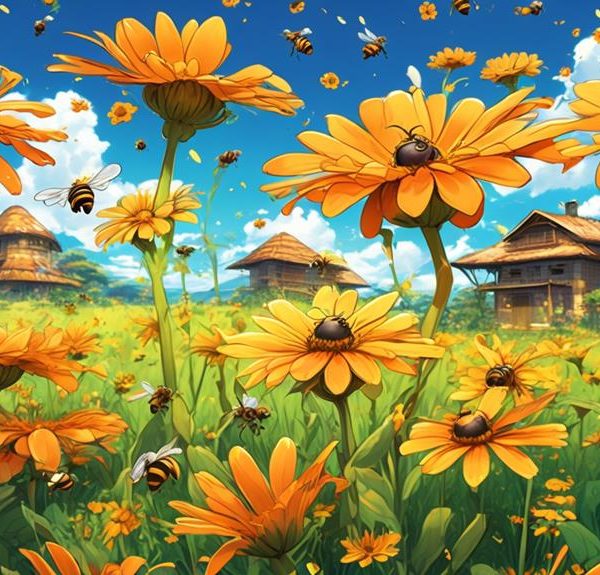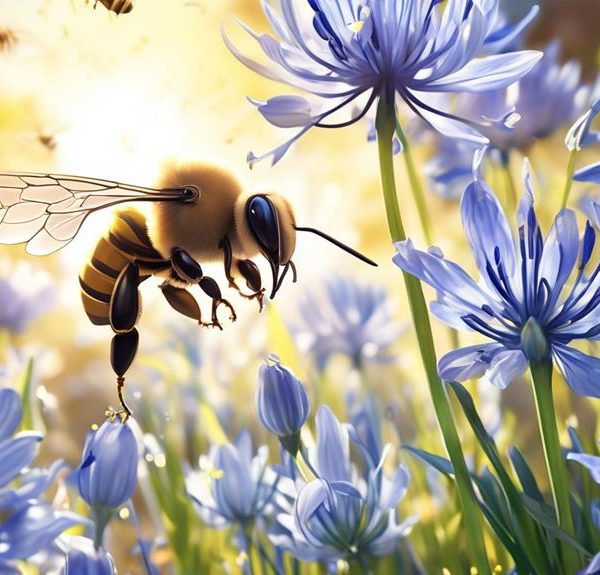Intriguing factors determine if bees are attracted to African Marigolds – explore the surprising answer!

Do Bees Like African Marigolds?
'As the saying goes, 'you can catch more flies with honey than with vinegar', but when it comes to bees, what's the best flower to attract them?
You might be considering the vibrant African Marigold, known for its bright hues and distinctive fragrance, but does it really hold an allure for these tireless pollinators?
The answer isn't as clear-cut as you might think and hinges on a number of fascinating factors that will have you buzzing with anticipation to explore further.'
Key Takeaways
- Bees are attracted to African Marigolds due to their abundant nectar production, intricate flower structure, strong fragrance, and nutritious pollen.
- Scientific studies confirm that bees are drawn to the bright colors and scent of African Marigolds.
- Planting African Marigolds in large clusters and ensuring consistent blooming throughout the bee active season can enhance bee attraction.
- Choosing single-bloom varieties and utilizing the vibrant orange and yellow hues of African Marigolds can maximize their visibility to bees.
Understanding Bees' Flower Preferences
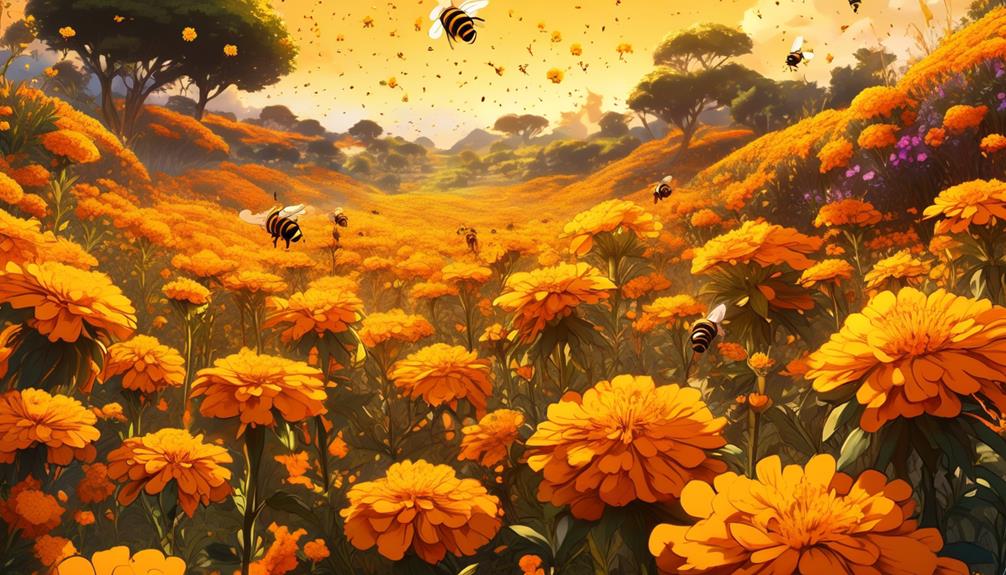
Often, you'll find that bees' preferences for flowers are intricately linked to the plant's shape, color, scent, and nectar production. Bees aren't random foragers; they're discerning pollinators with a keen sense for specific floral traits. To understand this, let's delve into the science behind their preferences.
Shape matters. Bees are attracted to flowers that provide a landing platform. They prefer a complex shape like that of snapdragons, which requires them to 'work' for their nectar, thereby ensuring better pollen transfer.
Color is crucial too. Bees can't see red, but they're attracted to yellow, blue, and ultraviolet colors, which are prevalent in marigolds. They also prefer flowers with contrasting colors, which act as a beacon, guiding them to the nectar.
Scent plays a significant role. Many flowers emit a fragrant call to action, which can be irresistible to bees. However, they're less attracted to strong, overpowering scents than to mild, sweet ones.
Lastly, nectar production is key. Bees are drawn to flowers with abundant, sweet nectar. It's this nectar that provides them with necessary energy and nutrients. Therefore, flowers that produce ample nectar, like marigolds, are highly favored by bees.
African Marigolds: A Brief Overview
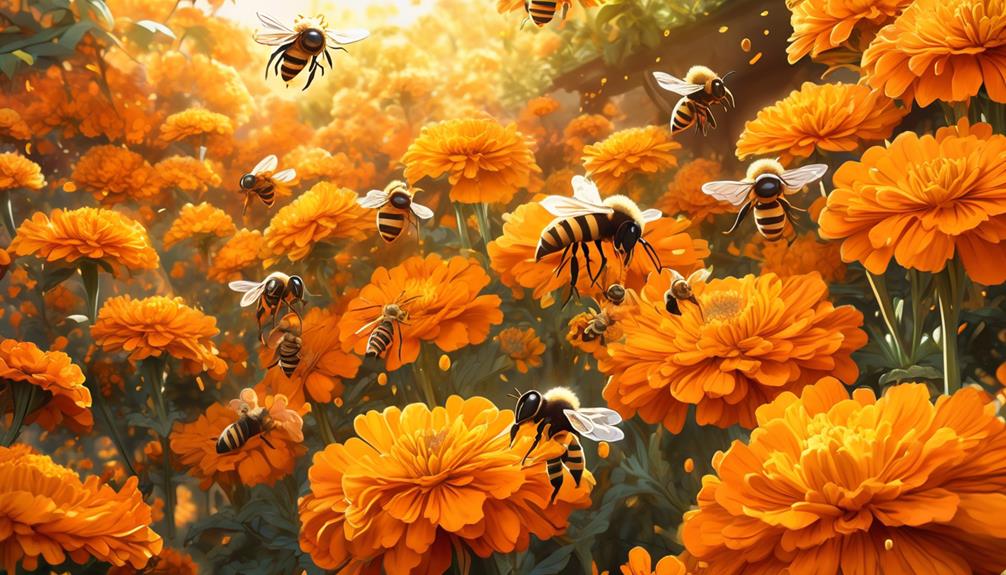
Boasting vibrant hues and a distinctive shape, African Marigolds – scientifically known as Tagetes erecta – are a bee magnet that you'll commonly find in gardens worldwide. These plants belong to the Asteraceae family and are native to Mexico and Central America. They've become popular due to their ability to thrive in a wide range of soil types and climatic conditions.
You'll recognize African Marigolds by their large, pom-pom-like flowers that range in color from bright yellows to deep oranges. They can reach up to 3 feet in height, making them a striking addition to any garden. They're not just for show, though. African Marigolds have a strong, pungent scent that's been shown to repel certain pests, including nematodes and whiteflies.
But what makes African Marigolds particularly interesting is their relationship with bees. The flowers produce a large amount of nectar, which attracts bees and other pollinators. The intricate structure of the flower also provides a challenge that helps the bees hone their foraging skills.
In short, African Marigolds are more than just pretty faces. They're hardy, versatile, and play a crucial role in supporting local bee populations.
The Allure of African Marigolds to Bees

You might wonder why bees are particularly drawn to African Marigolds. It's a combination of the generous nectar production and the complex flower structure that keeps these industrious pollinators coming back.
African Marigolds produce a copious amount of nectar, a critical source of energy for bees. This nectar is rich in sugars, providing the bees with the necessary fuel for their strenuous activities.
Apart from the nectar, African Marigolds are known for their intricate flower structure, characterized by dense clusters of florets. This provides a large surface area for the bees to forage, maximizing their efficiency. Moreover, these flowers produce a strong, sweet fragrance, potent enough to draw bees from a considerable distance.
The pollen of African Marigolds, abundant and highly nutritious, is another attraction. It's an excellent protein source for bees, essential for their growth and development. The bright color of the flowers, typically a rich orange or yellow, also serves as a visual cue for the bees, enhancing their attraction.
Scientific Studies on Bees and Marigolds
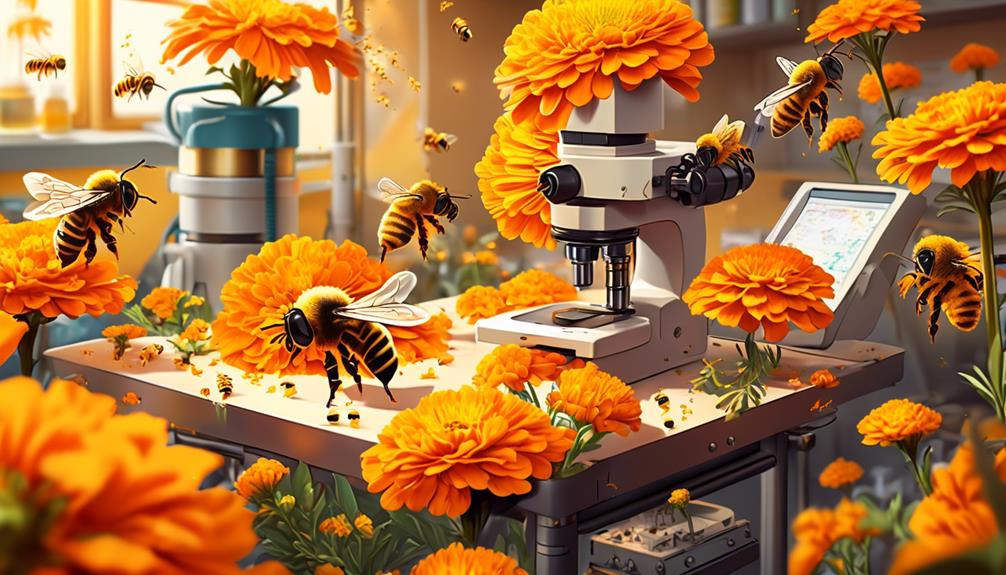
While the allure of African Marigolds to bees is quite evident, several scientific studies have been conducted to further understand this relationship, providing a deeper insight into the preference shown by bees for these vibrant flowers.
Research has indicated that bees are primarily attracted to the bright colors and strong scent emitted by these marigolds. A study conducted by the University of Sussex found that bees can perceive both the color and scent of flowers. In the case of African Marigolds, their bright yellow and orange hues are highly appealing to bees' vision. The flowers' potent scent, which is primarily due to a compound called terpenes, is another major factor in attracting bees.
In another research, it was discovered that African Marigolds produce a high amount of nectar, which is a primary food source for bees. This abundance of nectar makes the flowers even more desirable to bees.
Thus, through scientific research, it's clear that the allure of African Marigolds to bees isn't just a mere coincidence, but a result of the flowers' unique characteristics that cater to bees' specific needs and preferences.
Enhancing Bee Attraction With Marigolds

Given the clear affinity bees have for African Marigolds, it's possible to strategically use these flowers to enhance bee attraction in your garden or farm. By understanding the marigold's properties, you can utilize its potential to its fullest.
Marigolds produce nectar and pollen in abundance, both of which are vital food sources for bees. Their bright orange and yellow hues are highly visible to bees, who perceive these colors more intensely than others. To maximize their attractiveness, consider planting marigolds in large clusters. This creates a visual 'hotspot' that's likely to draw bees from considerable distances.
Furthermore, marigolds bloom for extended periods, providing a consistent food source. By ensuring that you have marigolds flowering throughout the bee active season, you're essentially setting up a dependable 'bee buffet', inviting these pollinators to frequent your garden.
However, it's important to note that not all marigolds are created equal. Research suggests that bees prefer single-bloom varieties over double-bloom ones, possibly due to easier nectar and pollen access. So, while planting marigolds, opt for single-bloom types to enhance your garden's bee-friendliness.
Frequently Asked Questions
What Other Flowers Do Bees Commonly Prefer Apart From African Marigolds?
You're curious about what flowers bees prefer, aren't you? Well, bees are especially fond of bright, fragrant blooms. They're particularly drawn to lavender, clover, and sunflowers. They also can't resist the allure of rosemary and poppies.
Bees tend to prefer native plants and are attracted to blue, purple and yellow flowers. So, if you're looking to attract more bees, consider adding these plants to your garden.
It's fascinating, isn't it?
How Can One Cultivate African Marigolds in Their Home Garden?
You'll need a sunny spot to grow African marigolds. Start by preparing well-drained soil and sow seeds about an inch deep, keeping a distance of a foot between each. They'll sprout in a week or so.
Water regularly, but avoid drenching. They're quite resistant to pests, but watch out for slugs. Feed them with a slow-release fertilizer to encourage blooms. Protective mulch can be useful in cooler climates.
It's that simple to have a beautiful marigold garden!
What Are the Other Benefits of African Marigolds Aside From Attracting Bees?
Aside from luring bees, African Marigolds offer numerous benefits. They're great for companion planting as they deter harmful pests like nematodes and rabbits.
Their vibrant blooms not only beautify your garden but also add color and flavor to salads.
Marigolds are also used in traditional medicines for their antiseptic and anti-inflammatory properties.
Are There Any Potential Hazards or Risks to Bees When They Interact With African Marigolds?
You're right to consider potential hazards for bees. However, African marigolds aren't harmful to bees. In fact, they're beneficial. They attract bees with their bright colors and strong scent. They also provide a good source of nectar.
Can African Marigolds Be Used in Beekeeping Practices and How?
Yes, you can use African Marigolds in beekeeping. They're excellent pollen providers, attracting bees with their vibrant colors and strong scent. Plant them near your hives. The bees will collect the pollen, aiding in honey production.
However, Marigolds are also known for their pest repellent properties, so they'll help keep harmful bugs away too. It's a win-win situation. Be mindful though, too many can overpower other plants, so balance is key.
Conclusion
In conclusion, bees are indeed attracted to African marigolds. Studies reveal that their vibrant color and rich nectar supply draw in these pollinators.
Planting marigolds not only enhances your garden's beauty, but also promotes bee activity. This, in turn, contributes to pollination and biodiversity.
Remember, your choice of flora can profoundly impact the local bee population. So, go ahead, add some African marigolds to your garden and watch the bees buzz in appreciation.

